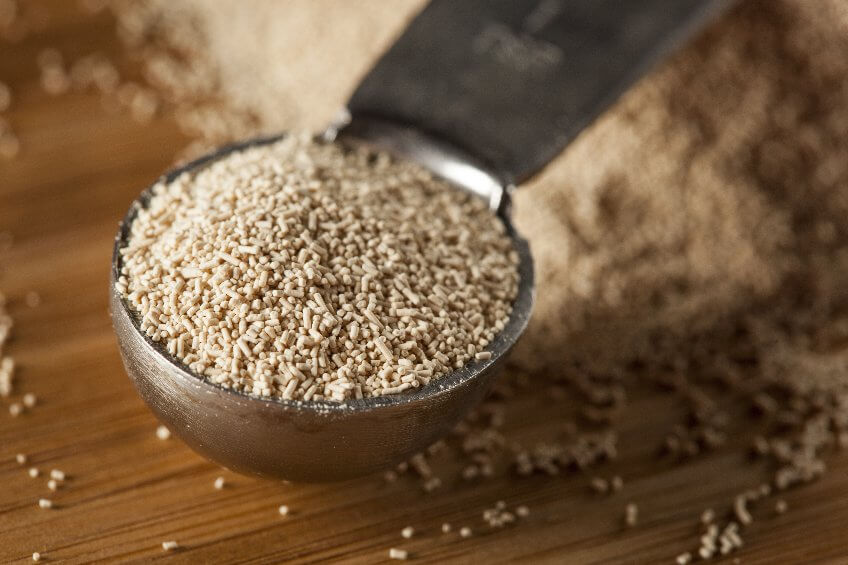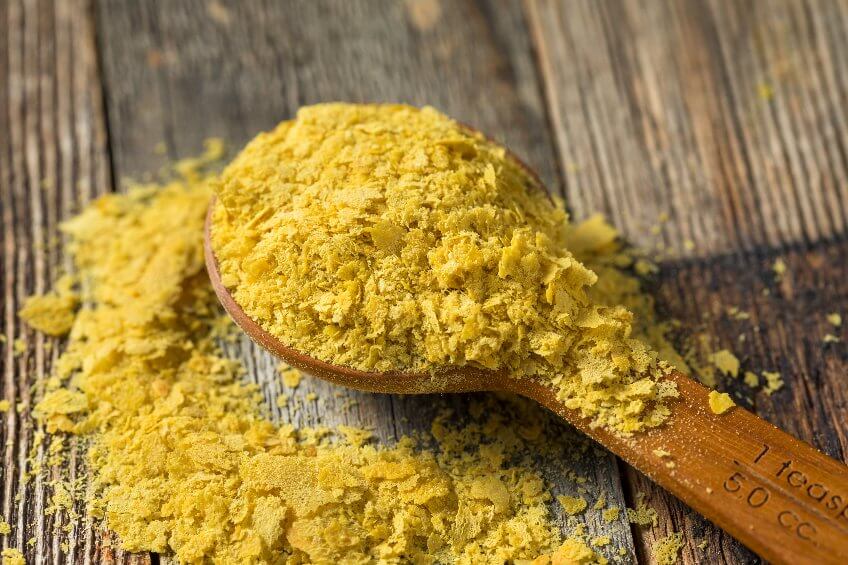Yeast is one of the most unique and mystifying food ingredients we consume on a near daily basis. There are many different types of yeast, however, and they’re used in different and for different reasons. In this article we’ll be comparing nutritional yeast vs active dry yeast to outline what the differences are between them.
In short, the difference between nutritional yeast vs active dry yeast is that one is an ingredient and the other is a seasoning. Active dry yeast is used in baking to make dough rise, whereas nutritional yeast is a seasoning used by vegans as a cheese alternative.
That said, there are several factors that set these two yeast products apart. Let’s have a closer look.
All About Active Dry Yeast
Sometimes referred to as baker’s yeast, active dry yeast is one of many different types of yeast that are used as an ingredient, functioning as a leavener to make dough rise. It comes packaged in glass jars and paper packets as tiny pellets that are a muted cream color.

Although it may not appear so, active dry yeast is actually alive (hence the “active” descriptor.) It consists of a single-celled organism that is cultivated on a growth medium. When exposed to sugar, these organisms consume it and produce carbon dioxide gas, which creates pockets of air and bubbles that cause bread to rise when baked. It also plays a role in giving bread a subtle but rich and earthy flavor.
For active dry yeast to work, however, it must be alive. If it has expired or become inactive for any other reason (such as exposure to high temperatures,) then there will be no living organisms to produce all of that carbon dioxide gas. As a result, you will have flat, flavorless bread.
To ensure that active dry yeast is alive, it must be proofed.
How To “Proof” Active Dry Yeast
Proofing is a way of testing your yeast for activity. It involves mixing it with some water and sugar, then waiting 5-10 minutes to see if it bubbles and foams. If it does, your yeast is active and good to use. However, if no foam is formed then it’s likely inactive and should be discarded.
The following video from the “Feast and Farm Cooks” YouTube channel demonstrates how to proof baker’s yeast using water and sugar:
It should be noted that yeast activity can be affected by altitude. Higher altitudes cause yeast to rise 25%-50% higher due to the lower air pressure.
Once opened, the unused portion of active dry yeast must be stored in the refrigerator.
Safety And Precautions
Although active dry yeast is meant to be used as a baking ingredient, some may attempt to eat it raw. This comes with potential risks though.
According to Leaf.tv, active dry yeast is unlikely to cause problems if eaten raw in a small quantity. However, it can lead to abdominal pain. It is also highly toxic to dogs, according to Puppy Leaks.
How About Nutritional Yeast?
Nutritional yeast is made from the same organism as active dry yeast, but it is used in a much different way. Nutritional yeast is a flaky and yellow-colored topping that functions as a vegan alternative to cheese.

The biggest difference between nutritional yeast vs active dry yeast is that nutritional yeast is an inactive type of yeast that is not alive. It is produced by culturing a single-celled organism (the same one used to make active dry yeast) on a growth medium– typically sugar or beetroot, according to Wikipedia.
The culturing process takes several days. Once completed, the yeast is exposed to heat, which inactivates it. It is then harvested in flakes that taste like cheese when eaten. The cheese flavor comes from the breakdown of the cell’s protein into an amino acid known as glutamic acid, according to Serious Eats.
It is then packaged, shipped, and marketed as a cheese-flavored seasoning that does not contain dairy.
How To Use Nutritional Yeast
As previously mentioned, nutritional yeast has a flavor that mimics cheese. And since it isn’t dairy-based like cheese is, it is often used as a vegan alternative to cheese.
Some of the ways it can be used include:
- Sprinkled on popcorn as a healthier alternative to butter
- Sprinkled onto pasta as an alternative to Parmesan cheese
- Added to salads for flavor
- Made into a savory cheese sauce
- Enhancing rice and bean dishes
- Topping potatoes and roasted veggies
Nutritional yeast opens up a world of possibilities for those who enjoy the taste of cheese but want to avoid the sodium, saturated fat, and cholesterol that typically comes with it.
The following YouTube video from the “How Do You Do” channel demonstrates a quick and easy way to use nutritional yeast on popcorn:
Nutritional yeast should be stored in a cool, dark place. It should also be airtight so moisture does not get in.
Health Benefits
Unlike active dry yeast, nutritional yeast often comes fortified with vitamins and minerals. In fact, vegans consume it not just as a dairy-free cheese alternative, but also as a source of vitamin B12.
Nutritional yeast also has additional health benefits associated with it, according to WebMD:
- It contains fiber, which may help reduce cholesterol levels.
- The type of fiber it contains (beta-glucan) is believed to help in strengthening the immune system.
- It also contains antioxidants that protect cells against free radicals.
That said, it’s not all sunshine and rainbows with nutritional yeast.
Potential Risks
Although WebMD classifies nutritional yeast as being safe for most people, it does come with some potential risks. For one, it may trigger headaches in those who experience migraines. Additionally, it may worsen symptoms for those with allergies.
Another area where it differs from active dry yeast is pet safety. Although active dry yeast is highly toxic to dogs, nutritional yeast is safe, according to Dogtime.
Nutritional Yeast VS Active Dry Yeast: In Summary
Now that we’ve gone over all of the minutiae of each yeast variety, we can conclude the following:
| Item | Nutritional Yeast | Active Dry Yeast |
 |
 |
|
| What Is It? | A seasoning | A baking ingredient |
| What It’s Used For | As a dairy-free alternative to cheese | As a leavening agent when baking breads and crusts. |
| How To Use It | Sprinkle some onto your food to add cheese flavor or make into a cheese sauce | Add some to water and mix in sugar to confirm if the yeast is still alive |
| Storage | Store in airtight packaging in a cool, dark place | Store in the refrigerator after opening. |
| Shelf Life | Up to 2 years if stored properly | Up to 4 months in the refrigerator; 6 months in the freezer |
| Health Benefits | Contains fiber, protein, and is fortified with vitamins and minerals | None |
| Potential Risks | May trigger migraines and allergy symptoms in those who are sensitive to them | Can cause abdominal pain if eaten raw |
| Pet Safety | Safe for dogs | Highly toxic to dogs |
Regardless of their differences, each type of yeast serves a unique purpose of its own, even if they come from the same organism.

